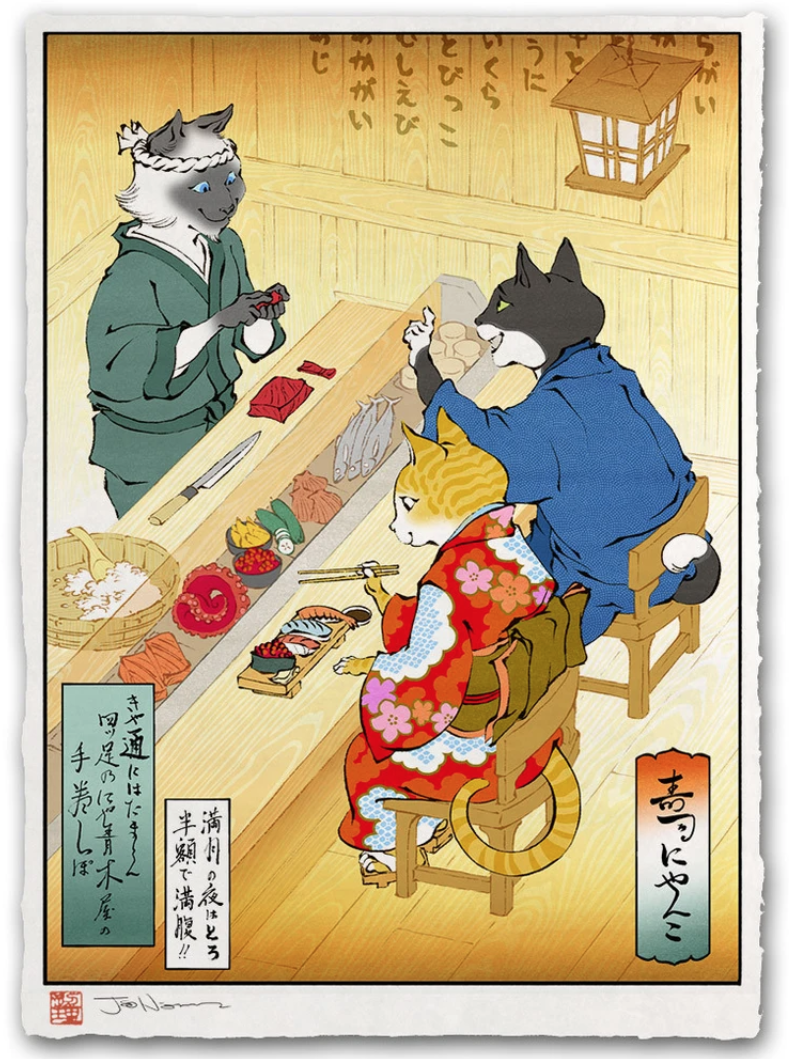Sushi Cats
Jed Henry, Sushi Cats, 2019, Archival pigment on handmade Japanese paper, 17 x 12 in.

Two of Japan’s biggest obsessions: cats and sushi! For centuries, Japanese artists have drawn cats in every way imaginable, and this my contribution to that tradition. So belly up to the bar and order a pawful of your favorite fish. But remember, caughing hairballs is bad table manners!
- The main title cartouche reads: 寿司にゃあんこ (sushi nyanko) ‘Nyan’ is Japanese for ‘meow’, and a ‘nyanko’ means ‘kitty’.
- The white cartouche reads: 満月の夜はとろ半額で満腹!! Which means: On Full moons, get a full tummy with half-price toro!” (Toro is the belly cut of tuna. It’s expensive and delicious.)
- The green cartouche is full of puns: きゃ通にはたまらん四ッ足のにゃ青木屋の手巻シッポ The basic meaning is: ‘The temaki sushi at Four-Leg Naoki’s is irresistable to cats.’ But when you look at the hidden puns, this title is thick with humor.
- きゃ通 (kyatsu): This reads as ‘kyatsu’ which sounds like ‘cats’ in English. As a pun, it contains the kanji 通, (tsuu) which means ‘a connoisseur’. So the word ‘cats’ actually means ‘connoisseur cats’, or ‘cats with good taste’.
- 四ッ足 : This reads as ‘yotsu-ashi’, which means ‘four-legged’. As a pun, it sounds a lot like ‘Yotsu-bashi’, an area in Osaka famous for its excellent dining.
- にゃ青木 : (nyaoki) ‘Naoki’ is a common Japanese man’s name. ‘Nyao’ is another word for ‘meow’. When you combine the two, you get a very appropriate cat’s name: Nyaoki.
- 手巻シッポ: (temaki shippo) ‘Te-maki‘ is a kind of sushi. ‘Maki-shippo’ means ‘curly tail’, referring to the short, bobtail genetic feature that is prominent in many Japanese cats. So when you combine the two, you get ‘temaki shippo’.
Jed Henry grew up in rural Indiana and “fell in love with video games”, most of which had their origins in Japan. “I escaped into the world of heroes, competition, and fun that Japanese gaming offered. Later, I served an LDS mission in the Tokyo area, where I fell in love with Japan and the Japanese people. Then, while a student at Brigham Young University, I had the opportunity to study Japan’s culture and history alongside my major field of animation. I began to wonder if there was a way to bring all the places, people, and characters I loved into one medium.
For hundreds of years, Japanese woodblock printmakers worked in a thriving popular art scene. Their prints depicted heroes, villains and monsters, spanning every genre from satire, to romance, to horror. This heritage is especially evident in Japan’s video game industry, a new chapter in an ancient, enduring culture. To celebrate Japan’s contribution to video games, Jed took his favorite game characters and returned them to the ukiyo-e woodblock-print style. He lives in Provo, Utah with his family.